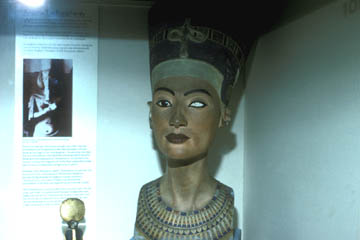Nefertiti's Eye
Following the scandal over the bust of Nefertiti - when an archaeologist admitted that the art treasure had been hidden from Egyptian assessors - the Berlin Museum where she resides was faced with a problem. In 2007 Zahi Hawass, the publicity hungry head of Egypt's Antiquities Department, put in an application for a "loan" of the bust. Suspecting, probably rightly, that possession is nine-tenths of the law and that once the bust reached Egypt it wouldn't come back, the German authorities turned the request down, claiming that the bust was too fragile to travel. With Egypt's claim to the bust strengthened, the authorities needed to strengthen their defences.

|
| A copy of the famous bust of Nefertiti in the Manchester Museum clearly shows the damaged eye. |
Back in 1992 the museum authorities arranged for a CT scan of the bust. Exactly why they did this is not clear, but the results were most interesting: the scan showed clearly that the famous face is actually made of painted stucco on a stone core. However back then the best that the CT scanner could manage was 5mm slices with a 5mm resolution, which is not very high detail. Modern CT scanners can do much better and Dr Alexander Huppertz, director of the Imaging Science Institute at the Charite Hospital in Berlin was asked to have another go.
The results were most interesting. Instead of just a roughly shaped core, the new scan reveals a complete stone face beneath the plaster. The new face is somewhat thinner, has a bump on the nose and deeper lines around the mouth, giving the famous queen a slightly gammin look.
The question that arises is who ordered the changes and why? Of course it could have been the sculptor, dissatisfied with his representation of the queen, but on the whole I think that unlikely. The beauty of the bust is such that I cannot believe it was turned out by a jobbing sculptor; it must have been created by an artist and the changes produced by the plaster coating would be a reflection on his skill.
Could the changes have been ordered by Akhenaton himself, unhappy over the way his wife was portrayed? That is possible, but again unlikely. If other Amarna Period artwork is anything to go by, any intervention by Akhenaton would have been to make the face more grotesque, like the statues and reliefs of the pharaoh himself.
Might it have been Nefertiti? Here we are, perhaps, on more solid ground, for feminine concern for looks is well-known. We know that at some point Nefertiti had a falling out with her husband and ended up banished to the North Palace. Some have pointed to the damaged eye of the bust to claim that Nefertiti's beauty was fading and her charm with it and so Akhenaton, the "lover of beauty" found it intolerable to live with her any longer.
Well, there's no telling what some men may do, but the closeness shown by the royal couple in the many reliefs which depict them and their daughters would seem to argue against this. No doubt there was a falling out, but it is more likely to be Akhenaton's infatuation with his daughters that led Nefertiti to withdraw in dudgeon, rather than a simple question of artistic sensibility.
However it may be the eye which gives the clue. The bust was found in 1912 by Ludwig Borchardt, lying on the floor of a sculptor's workshop. Given the beauty of the object this is a mystery that has never been adequately explained: why was it not installed in a temple or palace? The usual explanation is that it had been returned to the workshop for repairs, but that anomalous damage to the eye is hard to explain as mere accident.
The fact that the core of the bust is a completed face, which was then covered with a coating of plaster that refined and improved the face before the bust was discarded seems to me to point to a student receiving instruction from his master. The student creates the initial face and is then rebuked by his master over some defect - not true to life or it failed to live up to the artistic canons - who then slaps on a coat of plaster and improves the face. "Right, lad," our hypothetical master artist says. "Now finish that off and show us what you can do."
However once one eye has been finished the master calls his apprentice away to deal with a rush job and the incomplete head lies around the workshop until finally it falls from its stand and is lost to sight in the rubble of stone chippings on the floor.
Can I prove it? No, of course not, but if Egyptologists can speculate, so can I - and I think that my version is just as likely as theirs.
the damaged eye The damaged eye is a bit of a mystery. The ears of the statue are damaged, presumably by a fall or by having things dropped on the statue as it lay on the workshop floor. However the bust's nose is undamaged, as is the right eye, but the left eye is a white blank, perfectly framed by the undamaged eyelashes. This curious feature has caused some to speculate that in later life Nefertiti suffered from river blindness, in which a parasite causes the cornea to become opaque. Return
© Kendall K. Down 2009





